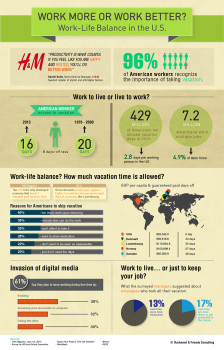
Navigating the minefield of work-life balance for American-Swedish business
The importance of maintaining a healthy work-life balance varies widely between countries like the United States and Sweden. The Dutch social psychologist Geert Hofstede has determined several dimensions of culture-explaining differences that also shed light on varied views of achievement and quality of life.
Swedes work to live…
A few weeks ago, I wrote about Americans working in the United States for a Swedish company. In my blog post “The Challenge of Cross-Border Communication,” I pointed out differences between these two countries, supported by the research of Geert Hofstede. Frank Garten, an intercultural business consultant commented on this post, stating that Swedes and Americans don’t share the same vision of a Work-Life Balance. Garten explained that “The Swedes . . . value the work-life-balance very much. There is time for work, and there is time for family and time off. I have experienced the Swedes however as very determined, thoughtful and precise at work: the quality of the end result is highly valued. For party there is little time in the office; they generally are serious, task-focused and un-emotional.”
… and Americans live to work
According to Hofstede, Sweden is a society where a person’s quality of life is a sign of success. In Sweden, keeping a healthy work-life balance is important. Those of us in the United States, however, face a dramatic difference: most Americans seek achievement above all. With my children attending American schools, I am a first-hand witness to this can-do mentality. Personally, I love the way teachers always find the right words to keep students motivated. This helps students feel as if it is always possible to try again and to improve. However, I know many French and German parents that don’t appreciate this mentality at all.
Productivity in American-Swedish business
Returning to our comparison of the work-life balance between Sweden and the United States, when it comes to international business, it is remarkable to see how different cultures approach management. Sweden is known as a very open and egalitarian country. In any discussion of gender equity, Sweden leads with its high percentage of working mothers, small gender employment-rate gap, and excellent parental-leave policies for both mothers and fathers. Does this mean Swedes are too soft for business?
Swedish brands: Volvo, IKEA, and H&M
H&M, IKEA, and Volvo are still in Swedish hands. Additionally, only a few people may remember that Skype came from Sweden before being sold to eBay and later to Microsoft. The same is true for Spotify, a music service that allows users to stream millions of tracks on computers and smartphones. Clearly, even if Sweden may be a so-called “feminine” society, its values don’t prevent its populations from conducting international business successfully.
According to the OECD, the favored metric for workforce productivity, GDP per capita is higher in Sweden than in the United States. By the way, Sweden offer 36 guaranteed paid days off to employees, while the United States is the only developed economy that doesn’t require employers to offer paid vacations.
Check out the infographic below for more insight into the American view of work-life balance.

You might also be interested in reading these articles:
Work-Life Balance in the United States
or Cross-Border Marketing is Dealing with Culture
Photo credit: © Minerva Studio




